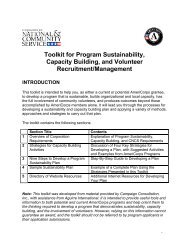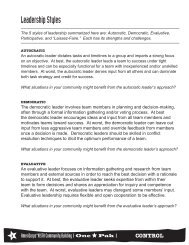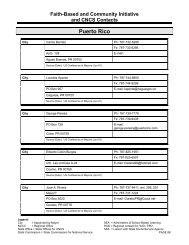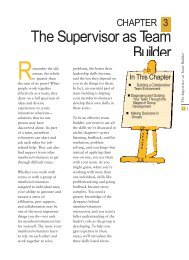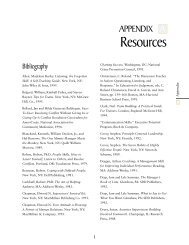MAKE IT LAST FOREVER: THE ... - National Service Resource Center
MAKE IT LAST FOREVER: THE ... - National Service Resource Center
MAKE IT LAST FOREVER: THE ... - National Service Resource Center
Create successful ePaper yourself
Turn your PDF publications into a flip-book with our unique Google optimized e-Paper software.
kind of systemic change they wish to see. Nevertheless, knowledge is power, and with an understanding of the change factors, people<br />
will have a greater capacity to influence the system in order to foster service-learning infusion.<br />
The fact that only 50% of the participants recommended to participate in this study ultimately turned out to be models of<br />
institutionalization is encouraging, in that there are now models to learn from in most every state; yet it is unfortunate that there are so<br />
few models, and such slow progress in the sustainability movement. The field has much work ahead of it to make service-learning<br />
completely accepted as a pedagogy, and this serves as a call to national experts and organizations in the field to concentrate on<br />
supporting the strategic planning process and many of the institutionalization strategies prioritized in this study. Institutionalization<br />
does not happen without concerted effort, and most practitioners are far too busy teaching to be addressing the educational system.<br />
This work provides a way for people to contact one another to discuss the various approaches; perhaps this will facilitate the<br />
replication of successful approaches throughout the country.<br />
Research Methodology<br />
This research consisted of interviews with state, district, school, and non-profit personnel involved with the coordination of<br />
service-learning at their educational level. All participants are or were funded by Learn and Serve, either as a subgrantee of the state or<br />
of a national direct program. Over 100 in-depth interviews were conducted from November, 1999 through May, 2000 with state<br />
Learn and Serve coordinators, district superintendents and curriculum directors, school principals, teachers, other service-learning<br />
coordinators, technical assistance providers, consultants and researchers. Of these 100 interviews, over 80 were conducted with<br />
schools and school districts.<br />
Study participants were selected from all five Learn and Serve regional clusters to reflect the diversity of the nation, in that<br />
they represent:<br />
• a cross-section of service-learning experience and capacity;<br />
• rural and urban circumstances;<br />
• small and large schools and districts;<br />
• populaces of different cultural backgrounds;<br />
• states with supplemental financial support and with only Learn and Serve funding;<br />
• <strong>National</strong> Leader Schools and novice practitioners;<br />
• Learning In Deed initiative participants and finalists and states which did not apply for the initiative<br />
Information was collected about their approaches to policy, training and technical assistance, youth leadership, peer mentoring,<br />
curricular integration and links to standards, resources, organizational dynamic, partnerships. These evolved into categories within<br />
which specific strategies fit. The information from each interview was collected using a standardized form, which facilitated future<br />
synthesis of results in each topic area. A master list was developed which linked each school, district and state to the categories of<br />
institutionalization strategies used successfully at that particular level.<br />
Participants were also asked to comment on which areas they found to be most important to their process and their success.<br />
From these subjective viewpoints, the strategy categories were prioritized into three levels: Essential, Important, and Supportive.<br />
These distinctions are subtle, because all the categories are useful, but some do seem to have a deeper and/or broader impact than the<br />
others. A diagram illustrating these category levels was developed, and each category was also distinguished according to how it helps<br />
9



